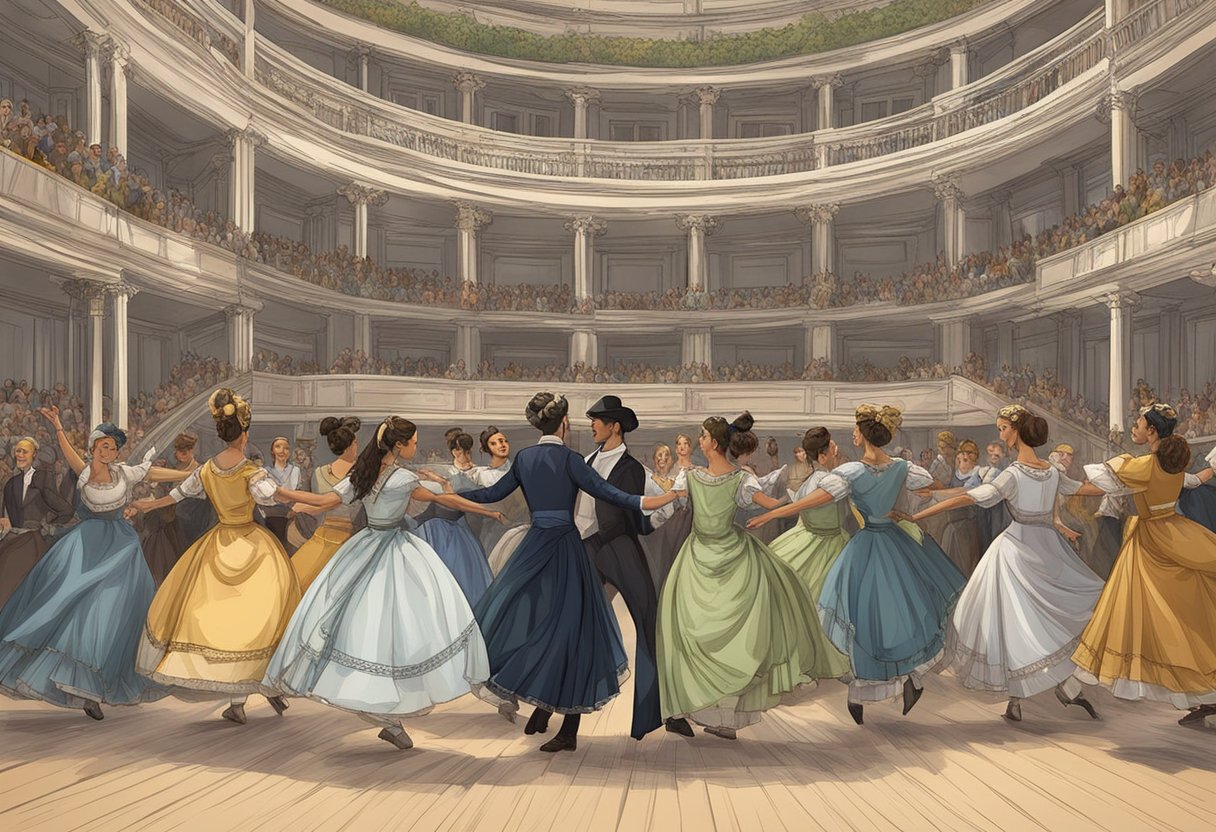Types Of Dancing
Dancing is an art form that has been around for centuries. It is a form of expression that has captivated people all over the world. There are many different types of dances, each with its unique style and history. From classical ballet to hip hop, there is a dance style for everyone.
Historically, dancing was used as a form of celebration, storytelling, and religious expression. Over the years, it has evolved into a form of entertainment and art. Classical dance forms like ballet, modern, and contemporary dance are still popular today. These dances require years of training and practice to perfect the movements and technique.
In recent years, there has been a rise in popularity of street and club dance movements. These styles are often more free-form and allow for self-expression. Global and cultural dance forms are also gaining popularity as people are becoming more interested in learning about different cultures and traditions.
Key Takeaways
- Dancing is an art form that has been around for centuries and has evolved over time.
- Classical dance forms like ballet and modern dance require years of training and practice.
- Street and club dance movements, as well as global and cultural dance forms, are becoming more popular.
Historical Overview of Dance

Dance has been part of human history since its earliest origins, bringing transcendence to spiritual rituals and creating bonds within communities. The evolution of dance has been influenced by various factors such as social, cultural, and religious practices.
Evolution of Folk Dances
Folk dances have evolved over time and have been passed down through generations. These dances were often used to tell stories, celebrate important events, and bring communities together. The earliest evidence of dance dates back to the Neolithic period, around 3500-3000 BC. This is seen in depictions of dancing figures found in wall paintings and artifacts from ancient cultures such as the Egyptians and Minoans. These images show that dance was used as part of religious ceremonies, celebrations, and social gatherings.
Folk dances have evolved differently in different parts of the world. African folk dances, for example, are often characterized by energetic movements and the use of drums and other percussion instruments. European folk dances, on the other hand, often involve intricate footwork and are performed to the accompaniment of traditional instruments such as the fiddle and accordion.
Rise of Ballet and Ballroom
The rise of ballet and ballroom dance can be traced back to the courts of European monarchs in the 16th and 17th centuries. Ballet was developed as a form of court entertainment and was characterized by its graceful movements, elaborate costumes, and use of classical music. Ballroom dance, on the other hand, was developed as a social dance and was popularized in the 19th century. It involves a variety of partner dances such as the waltz, foxtrot, and tango.
In conclusion, the history of dance is a fascinating journey that has been shaped by various cultural, social, and religious practices. Folk dances have evolved differently in different parts of the world and continue to be an important part of many cultures. Ballet and ballroom dance have also played an important role in the evolution of dance and continue to be popular forms of dance today.
Classical Dance Forms
Classical dance forms refer to those dance styles that have a long history and are considered to be an art form. They are usually performed in theaters and are characterized by their grace, elegance, and precision. Two of the most well-known classical dance forms are ballet and ballroom dancing.
Ballet Fundamentals
Ballet is a highly technical form of dance that originated in the Italian Renaissance courts during the 15th century. It has evolved over the centuries and is now performed all over the world. Ballet is known for its graceful, flowing movements and its emphasis on technique, precision, and control.
Some of the fundamental elements of ballet include turnout, which is the outward rotation of the legs from the hip; pointe work, which involves dancing on the tips of the toes; and the five basic positions of the feet. Ballet dancers also use a variety of jumps, turns, and lifts to create beautiful and complex choreography.
Characteristics of Ballroom
Ballroom dancing is a social dance that originated in the 19th century. It is a partner dance that is performed in ballrooms and other social settings. Ballroom dancing is known for its elegant and graceful movements, as well as its emphasis on posture, poise, and style.
There are several different types of ballroom dances, including the waltz, tango, foxtrot, and Viennese waltz. Each of these dances has its own unique characteristics and style. For example, the waltz is a slow, graceful dance that is characterized by long, sweeping movements, while the tango is a more dramatic and passionate dance that is known for its sharp, staccato movements.
Overall, classical dance forms are a beautiful and timeless art form that continues to captivate audiences all over the world. Whether it’s the precision and technique of ballet or the elegance and style of ballroom dancing, these dance styles are a testament to the power and beauty of human expression.
Popular Modern and Contemporary Styles
Jazz and Tap Dance
Jazz and tap dance are two popular modern dance styles that originated in the United States. Jazz dance is characterized by its energetic and rhythmic movements that are often performed to upbeat music. The style incorporates elements of ballet, modern dance, and African-American vernacular dance. Jazz dance is known for its fluidity, expressiveness, and improvisation.
Tap dance, on the other hand, is a form of dance in which the dancer wears shoes equipped with metal taps that create rhythmic sounds when the dancer strikes the floor. Tap dance is often performed to jazz or swing music and is known for its syncopated rhythms and intricate footwork.
Both jazz and tap dance require a great deal of technical skill and physical endurance. Dancers must have excellent coordination, balance, and timing to execute the movements with precision and flair.
Modern and Contemporary Dance
Modern and contemporary dance are two related styles of dance that emerged in the early 20th century as a reaction to the rigid conventions of classical ballet. Modern dance emphasizes the use of the entire body in expressive and creative ways, while contemporary dance incorporates elements of various dance styles, including jazz, ballet, and modern dance.
Modern and contemporary dance are characterized by their emphasis on body movements, expression, and choreography. Dancers use their bodies to convey emotions and tell stories through movement, often incorporating elements of improvisation and experimentation.
In modern and contemporary dance, choreography plays a crucial role in shaping the performance. Choreographers use a variety of techniques, including improvisation, repetition, and manipulation of movement, to create unique and compelling works of art.
Overall, modern and contemporary dance offer dancers and audiences alike a rich and diverse range of styles and techniques that continue to evolve and push the boundaries of what is possible in dance.
Global and Cultural Dance Forms
Dance is a universal language that is expressed differently in various cultures around the world. From Latin and Afro-Caribbean rhythms to dances from around the world, there are many unique dance forms that represent the cultural heritage of different regions.
Latin and Afro-Caribbean Rhythms
Latin and Afro-Caribbean rhythms are some of the most popular dance styles around the world. These dances are known for their energetic and passionate movements that are often performed with a partner. Some of the most popular Latin and Afro-Caribbean dance styles include salsa, merengue, and rumba.
Salsa is a popular dance style that originated in Cuba and has since spread throughout Latin America and the world. It is a lively dance that requires quick footwork and fluid movements. Merengue, on the other hand, is a dance style that originated in the Dominican Republic and is known for its fast-paced rhythm and hip movements. Rumba is a dance style that originated in Cuba and is characterized by its sensual and romantic movements.
Dances from Around the World
There are many unique dance forms from around the world that represent the cultural heritage of different regions. From flamenco in Spain to bhangra in India, these dances are a reflection of the history and traditions of their respective cultures.
Flamenco is a dance style that originated in Spain and is known for its passionate movements and intricate footwork. Bhangra, on the other hand, is a folk dance that originated in the Punjab region of India and is characterized by its energetic movements and upbeat music. Bollywood dance is another popular dance style that originated in India and is heavily used in Indian Bollywood films.
In addition to these dance styles, there are many other folk dances from around the world that are unique to specific cultures. These dances often have a rich history and are an important part of the cultural identity of the communities that practice them.
Street and Club Dance Movements
Street and club dance movements have become increasingly popular over the years, with a wide variety of styles and techniques being developed. These styles are often characterized by their fluid and expressive movements, as well as their connection to urban culture. In this section, we will explore some of the most popular street and club dance movements, including hip-hop and breakdancing, as well as disco and electronic styles.
Hip-Hop and Breakdancing
Hip-hop and breakdancing are two of the most well-known street dance styles. Hip-hop dance is a type of dance that is performed to hip-hop music or that has developed as a part of hip-hop culture. This style of dance often incorporates a wide range of movements, including popping, locking, and breaking. Breakdancing, also known as b-boying or breaking, is a style of street dance that originated in the Bronx in the 1970s. It is characterized by acrobatic and athletic movements, including spins, flips, and freezes.
Disco and Electronic Styles
Disco and electronic styles are two other popular types of street and club dance movements. Disco dance originated in the 1970s and is characterized by its upbeat and energetic movements. It often incorporates elements of funk and soul music, and is known for its flashy costumes and disco balls. Electronic dance styles, on the other hand, are more modern and are often associated with electronic music genres such as techno, house, and trance. These styles often incorporate complex footwork and are known for their high-energy and fast-paced movements.
Overall, street and club dance movements are a vibrant and exciting part of modern dance culture. Whether you prefer the fluid movements of hip-hop and breakdancing or the high-energy beats of disco and electronic styles, there is something for everyone in this dynamic and ever-evolving dance genre.






